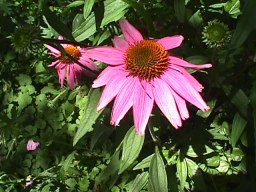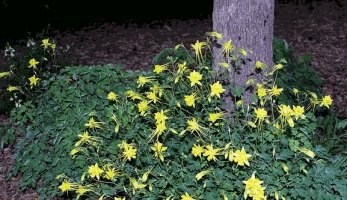
| home | club | plants | critters | in
the garden |
in
the home |
Wildscape | North
TX calendar |
|
|

|
||||||||||
|
|||||||||||
|
Strictly Natives - Gailon
Hardin  Purple
coneflower grows two feet high, has 4" daisy flowers with prominent cone-like
dark purple centers and lavender petals drooping downward and normally blooms
July and August. In mild winters, it can start blooming in March. It will
grow in most soils but takes a little more water than most natives. It still,
however, must be well drained and is one of those wonderful plants that
will take dappled shade to full sun. Purple
coneflower grows two feet high, has 4" daisy flowers with prominent cone-like
dark purple centers and lavender petals drooping downward and normally blooms
July and August. In mild winters, it can start blooming in March. It will
grow in most soils but takes a little more water than most natives. It still,
however, must be well drained and is one of those wonderful plants that
will take dappled shade to full sun. Propagation is easy. Once temperature gets 70 degrees, sprinkle seed in spring or summer outdoors and watch the seedlings emerge in 10 to 20 days. Started early, it blooms the first year. Rodale's Illustrated Encyclopedia of Herbs, Rodale Press, Emmaus, Pennsylvania, 1987.
 Yellow
Columbine is one of the many native plants that will grow in full to part
shade. It's brilliant yellow color brightens a dark corner and is evergreen
throughout our winters. In good soil it can become a three-foot mound of
green with it's yellow flowers and long spurs reaching upward another foot
or two. Columbines will grow in sand, loam or limestone and require a moist
well-drained site. Be careful not to plant the yellow and red varieties
together; they cross pollinate and create a yellow/red combination of the
two that is not at bright as either original. Yellow
Columbine is one of the many native plants that will grow in full to part
shade. It's brilliant yellow color brightens a dark corner and is evergreen
throughout our winters. In good soil it can become a three-foot mound of
green with it's yellow flowers and long spurs reaching upward another foot
or two. Columbines will grow in sand, loam or limestone and require a moist
well-drained site. Be careful not to plant the yellow and red varieties
together; they cross pollinate and create a yellow/red combination of the
two that is not at bright as either original.If you're interested in propagating Columbine, collect seed as soon as the flower withers and turns brown and the seeds are black in late May or early June. Remove the brown follicle and turn upside down into a container. Allow the follicles to dry for a few days, plant outside immediately or refrigerate for later planting. When planting in the greenhouse, sow the seed in a vermiculite mixture tamp lightly to help hold seeds in place. They need light to germinate, so make sure you can see the seeds on the surface. The seeds germinate within one week; however, they grow slowly. Be patient and do not fertilize young seedlings. They will be ready to transplant into individual containers in six to seven weeks. Mature plants may be divided in the fall. Take care when transplanting not to break too many roots and water immediately after replanting. References: Jill Nokes, How to Grow Native Plants of the Southwest, Texas Monthly Press, 1986. Sally Wasowski and Andy Wasowski, Native Texas Plants Landscaping Region by Region, Gulf Publishing Company, 1997. Harry R. Phillips, Growing and Propagating Wild Flowers, The University of North Carolina Press, 1985.
Cross-vine (Bignonia capreolata) is a vigorous evergreen woody vine capable of reaching 65-70 feet. It climbs via tendrils, has showy 2 inch bell-shaped red and yellow flowers and blooms normally from April to June. However, with our mild winter this year, they started blooming two months earlier. The vine grows in full sun to full shade in rich moist east Texas swamps and in my dry seldom watered sand in North Central Texas. Since cross-vine is a Texas native, it will come true from seed. Collect the flat leather seed pods in late summer through fall when they are light brown and begin to dry. They will remain viable up to one year if kept in sealed containers in the
References: Jill Nokes, How to Grow Native Plants of the Southwest, Texas Monthly Press, 1986. Sally Wasowski and Andy Wasowski, Native Texas Plants Landscaping Region by Region, Gulf Publishing Company, 1997. |